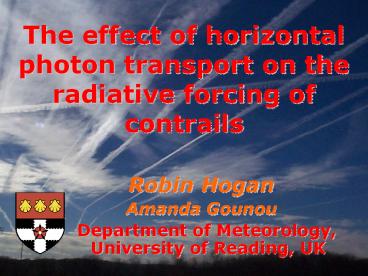Robin Hogan - PowerPoint PPT Presentation
Title:
Robin Hogan
Description:
The effect of horizontal photon transport on the radiative forcing of contrails Robin Hogan Amanda Gounou Department of Meteorology, University of Reading, UK – PowerPoint PPT presentation
Number of Views:116
Avg rating:3.0/5.0
Title: Robin Hogan
1
The effect of horizontal photon transport on the
radiative forcing of contrails
- Robin Hogan
- Amanda Gounou
- Department of Meteorology, University of
Reading, UK
2
Motivation
- IPCC Aviation Special Report (1999)
- 1992 global contrail coverage 0.1 ? net
radiative forcing 0.02 W m-2 - 2050 global contrail coverage 0.5 ? net
radiative forcing 0.1 W m-2 - In SE England in winter, forcing currently 0.5 W
m-2 (Stuber et al., Nature 2006) - Although the net effect is quite small, there is
a large degree of cancellation between the
shortwave and longwave effects - A small change in either of these could have a
large impact on the net forcing - Nearly all previous studies have used the
independent column approximation (ICA) - 3D effect neglected but photon transport through
contrail sides may be important - Here we use the 3D SHDOM radiation code to
estimate contrail forcing - Secondary motivation it can be difficult to
explain the difference between ICA and 3D
radiation in clouds - Contrails are perfect for visualizing the various
effects - Simple quasi two-dimensional geometry
- Low optical depth so longwave and shortwave
effects not yet saturated
3
Experimental configuration
q solar zenith angle f solar azimuth angle
- SHDOM 3D radiation code (Evans 1998)
- Periodic in both horizontal directions
- Contrail infinite in one horizontal direction
- Compare ICA and 3D runs
Contrail thickness 400 m
Shortwave optical properties Yang et al. (2000)
Longwave optical properties Mie theory
Contrail shape Elliptical (cos dependence of IWC on dist. from center)
Solar azimuth angle 0 (perpendicular) and 90 (parallel)
Contrail height 10 km (-50C in US Standard Atmosphere)
Control Experiments
Mean optical depth at 0.55 mm 0.2 0.2-0.6
Particle type Solid columns Spheres bullet rosettes
Effective radius 10 ?m 5-25 ?m
Contrail width 800 m 400-1200 m
4
- Shortwave downwelling flux
- Longwave upwelling flux
5
Independent column approximation
Control contrail
Longwave upwelling radiation absorbed emitted at
lower brightness temperature warming effect on
climate, positive forcing
- Shortwave solar radiation reflected back to
space cooling effect on climate, negative
radiative forcing
Radiative forcing difference in mean
top-of-atmosphere upwelling irradiance between
the calculations with and without a contrail,
then scaled up to an equivalent contrail cover of
100
6
3D radiative transfer
Control contrail
- Radiative forcing difference in mean
top-of-atmosphere upwelling irradiance between
the calculations with and without a contrail,
then scaled up to an equivalent contrail cover of
100
7
Why is there a 3D shortwave effect?
Photon escape
8
Why is there a 3D shortwave effect?
.
Effect 2
Side illumination
9
Why is there a 3D longwave effect?
Contrail edge absorption
Effect 1
10
Effect of particle type columns
Control contrail
- For effective radius of 10 mm and wavelength of
0.55 mm, solid columns have an asymmetry factor g
of 0.75 (similar for bullet rosettes)
11
Effect of particle type spheres
Sign of net forcing is reversed
Reduced shortwave forcing
- Spheres have an asymmetry factor g of 0.85 more
forward scattering
12
Effect of contrail optical depth
d0.4
3D net effect is a factor of 2 or more for all
solar zenith angles
d0.2 (control)
- Doubling of optical depth
- Shortwave forcing doubles
- Less than a doubling for the longwave forcing
(partial saturation)
13
Effect of contrail aspect ratio
q80
q40
- As contrails age they tend to spread out
horizontally - We keep thickness constant (400m) and vary width
- 3D effect tends to vary in proportion to the
aspect ratio - Aged contrails have a lower 3D effect
14
Conclusions
- Three ways can be identified by which 3D
transport affects forcing - Solar photons can escape through the sides of the
contrail - The sun illuminates contrail sides, lengthening
the shadow cast by the contrail - Upwelling longwave photons can be absorbed by
contrail sides - For solar zenith angle qlt70, inclusion of 3D
transport - Increases the longwave warming effect of the
contrail on climate - Reduces the shortwave cooling effect of the
contrail on climate - This results in a substantial net warming effect
- For 70ltqlt90
- The shortwave forcing is strongly dependent on
solar azimuth angle - Net forcing can be doubled or its sign can be
reversed! - There is a need to re-evaluate the global impact
of contrails on climate to account for the
effects of 3D transport































